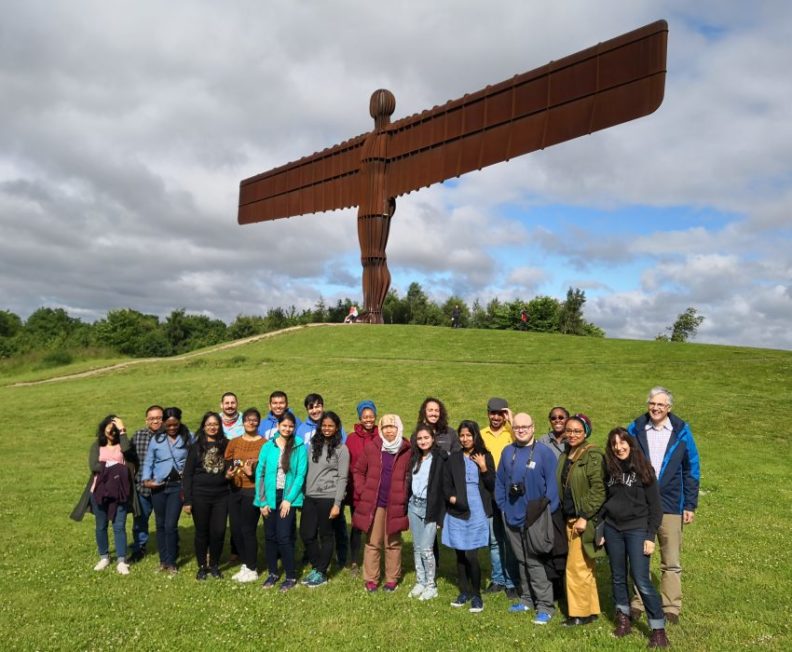COVID-19 Overshadows Efforts to Fight HIV/AIDS in Uganda
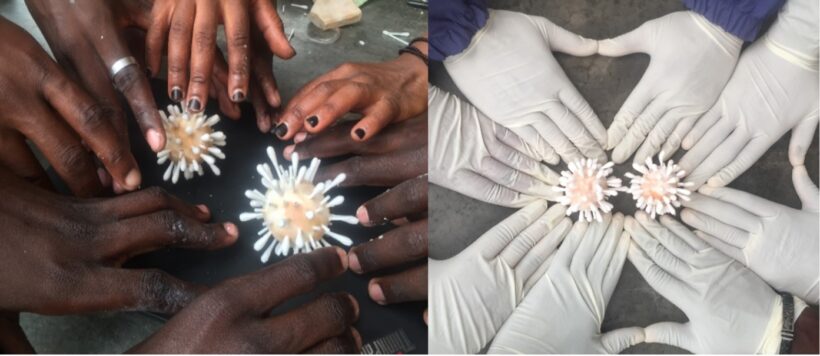
With coronavirus spreading across countries globally in the last three months since it’s out-break in Wuhan city, China, all governments the world over have passed tough preventive measures to control the spread of the pandemic. Major behavioural, clinical and state interventions have been undertaken to mitigate the pandemic, and to prevent the spread of the virus further into the communities These measures have ranged from enforcement of travel bans by air and road (limiting human mobility), lockdown of most human activities particularly in crowded cities with a few exceptions (banks, pharmacies, hospitals, food shops, etc.), creating quarantine zones and houses, establishment of COVID-19 testing/emergency centres, emphasising social distance (avoiding contact-based greetings, ensuring a one-metre distance between individuals, avoiding hugging and kissing), home-staying and home-working, regular hand washing with sanitizers and wearing of face masks. It remains unclear how the imposed restrictions and unprecedented preventative measures will affect life among local communities particularly in Sub-Saharan countries.
On Tuesday, March 24, just 3 days after Uganda had registered its first COVID-19 victim, the President of Uganda banned taxis, boda bodas and buses from operating for two weeks. In over a week, the Ministry of Health had recorded five more cases of coronavirus, bringing the total number to 9 (Tugume, 2020). Today 22 May 2020, the Health ministry has confrimed 15 new covid-19 cases. The total number of COVID-19 cases registered in Uganda now stands at 160. According to Dr Henry Mwebesa, the director general of health services at the ministry, 10 of these cases are truck drivers who arrived via Elegu border post while five cases are among community samples. He said that all community cases were under quarantine at the time of the test. The Ministry of Health Senior Public Relations Officer, Mr Emmanuel Ainebyoona said there are 97 active COVID-19 patients currently admitted to hospitals across the country. So far the reports from the ministry of health show that has no death have been recorded yet (Owiny, 2020).
Following the ban on public gatherings and movement of people using the usual transport means (mainly taxis, boda bodas and buses) to and from working spaces, medical placements, support and intervention centres including affecting tours, expeditions and business trips; there has been a sharp drop on the mobility of people within the country. Currently state interventions are focused on (i) Creation and management of testing centres, (ii) quarantining of COVID-19 suspects, and (ii) the enforcement of the presidential directives of no passenger movement on boda bodas, taxis and buses across the country as a preventive measure to control the spread of the pandemic (Ahabwe, 2020). With no active civil aviation and complete ban on passengers commuting in and around the country, many people particularly those in remote country side have been left stranded. This has unfortunately affected every single sector of the economy but most importantly and for the purpose of this article, I would like to focus on the how these COVID-19 measures have affected the fight against HIV/AIDS among local communities in Uganda.
The effects of the travel ban
Given the nature and economic status of the average Ugandan, the majority of the population rely on road transport as the most convenient mode for commuting to work places, medical facilities and other places of destiny. With the ban on all taxis and buses, private car owner have taken an advantage to extort money from travellers, particularly those seeking medical support from hospitals and other health centres around the country. They include patients with long standing medical/ health support routines and regular diagnostic interventions such as HIV/AIDS, cancer and TB patients. To access major referral health facilities in Kampala one has to unavoidingly use taxis through the taxi park and connect to these hospitals. The ban now left most vulnerable people especially HIV/AIDS and Cancer stranded patients’ lives in danger. Whilst a few who can afford alternative means of access using hired vehicles are facing adopting to the growing stigmatised atmosphere of social distancing and conformity to changing ethics of treatment related to COVID-19 because of its characteristic discriminatory nature of spreading within spaces. The growing fear among the medical support fraternity and the absence of a likely cure to the new pandemic has caused panic and anxiety among medical staff who have tried to stay put for emergencies in the different hospitals around the country. In Uganda, at least 1.4 million people are living with HIV. Milly Katana, a public health specialist, told the Guardian that the coronavirus lockdown is ‘unfortunately’ not locking up HIV. “I have information from Ankole districts [in western Uganda] where patients are in a desperate situation, walking for seven hours, sleeping at health facilities and going back the following day,” said Katana, warning that the situation could lead to drug resistance. Many people are running out of Anti-retrovirals (ARVs). This is even more worrying given that dolutegravir (DTG), the first-line drug of choice, has a very short ‘temper’. Miss a few doses and one gets a resistant strain of HIV. The next HIV epidemic will be resistant to not only DTG, but the drugs in the same class” (The Guardian, 2020).
Social distancing and prohibition of public gatherings
Historically, Ugandans are considered to be friendly people with a high sense of hospitality which has helped the country enjoy cordial benefits from the tourism industry. The Baganda of central region, in particular, are fondly known to be a welcoming community under the stewardship of this highness the Kabaka. Customs, traditions and norms permits greeting and sharing pleasantries involving shaking hands and sometimes hugging as a sign of love or a welcoming gesture. This practice like in other cultures has been now been squashed in a protracted effort to control the spread of coronavirus which started in China last year. All communities across the world have been advised to desist from contact-based greetings in order to minimise the threat of contracting this new disease. According to the World Health Organisation, social distancing and avoidance of crowded places are some of the scientifically confirmed ways of controlling the deadly pandemic within communities (WHO, 2020). A recommended one-metre distance between individual means doing away with contact-based greetings (hand shaking) and other forms of greetings or interactions such as hugging, kissing and whispering. As proximity to one another in public commuters and spaces increases the risk of contracting coronavirus, Firth Raymond in his interpretation of rituals observed that whereas greetings are meant to uphold a recognised encounter between persons as socially acceptable, sometimes “an encounter of a physical kind may take place without such social relationship-as by two persons rubbing shoulders in a bus” (Firth, 1972). This, as a matter of fact, demonstrates how crucial it is to advocate for emphasising social distancing and the banning of public gathering as such inevitable encounters could simply be unavoidable. However, all these actions, much as they are meant to control the spread of the pandemic, have incidentally caused a kind of stigma that makes every individual in society a suspect and as such people with simple colds and sinuses have been susceptible to discrimination in social spaces at home and away.

Biomedical interventions seem to present a concise response to the COVID-19 impact on health clinical measures to protect human rights with key pointers towards addressing stigma and discrimination in general. However, the impact of COVID-19 on people living with HIV is not fully known yet. At present there is no evidence to suggest that there is an increased risk of infection and increased severity of illness for people living with HIV (with the understanding that they are not immunosuppressed and/or have no other co-infections or co-morbidities). However, people living with HIV who are not on treatment or who are not virally suppressed may have a compromised immune system that makes them vulnerable to opportunistic infections and more severe illnesses (International AIDS Society, 2020).
Social actions and practices have curtailed the situation with a number of challenges stemming from the uncertainties surrounding the causal realities of COVID-19 and the impact on everyday lives of people in different communities, contexts and spaces. According to the International AIDS Society (IAS), a global organisation that leads collective actions on every front of the global HIV response, funding, researchers and healthcare workers are being diverted to work on COVID-19. They have recommended that it is important that quality HIV and general healthcare services remain available to people living with and affected by HIV to protect against HIV disease progression and complications from any other co-infections or co-morbidities, such as some prevalent chronic conditions like cancer and diabetes.
Proposals from leading health organisations including WHO have also recommended interventions such as task-shifting where possible, offering services via telemedicine and other innovative tools implemented more broadly such as self-testing or self-sampling using prepared sampling kits and sending preserved specimens safely via post. The use of telemedicine for initial symptom screening and triage and psychosocial support may facilitate social distancing without impacting the standard of care. On a grander scale, the global response to control COVID-19 may also influence health product supply chains, including logistics and shipping.
The major question here is: will efforts to increase logistical supply and funding alter the social impact of COVID-19 within societies and avoid the disruption of HIV support and implementation programmes for vulnerable persons in local communities? I want to argue that with the current re-direction of priority funding for health programmes, it is now extremely important to address the gaps brought about by these unprecedented preventive measures put in place by state authorities regarding the provision of alternative and restricted access to health facilities. It is necessary to balance the focus of interventions without compromising previous efforts to control and manage chronic ailments most especially HIV intervention Programmes across the country in order to minimise social stigma and discrimination associated and escalated by the COVID-19 outbreak.
A case for arts-based strategies to curb the spread of Covid-19
Singing for COVID-19 awareness
As was the case in the 1990s when HIV/AIDS was at its peak in Uganda, musicians such as the Late Philly Lutaaya with his AIDS song ‘Alone and frightened’ (Nalubwama, 2019) joined hands with government alongside Bakayimbira dramactors (led by Charles Ssenkubuge Siasa) to raise awareness about HIV/AIDS that was ravaging through communities. The engagement of visual arts has had a long tradition in collaborative efforts often geared towards empowerment, tackling social injustices, health challenges and popular issues concerning local communities. Today, Ugandan rapper-turned-politician Bobi Wine has released a COVID-19 song to raise awareness around the growing novel coronavirus outbreak. He collaborated with Nubian Li to spread the message of the importance of personal hygiene and social distancing. With ongoing research about SARS-CoV-2 – the new coronavirus yielding new information daily, and there is still much to learn.
Using art-based approaches such as music and sculpture, key information and other relevant messages can be remotely but swiftly conveyed to masses as substantive findings continue to point towards getting a feasible solution to the new out-break in the world. Engaging art-based practices such as drawing, applied sculpture or painting could provide an opportunity to arouse different awareness of the problems and situations associated with COVID-19; circumventing stigma caused by social distance and quarantining of persons who have tested positive. I argue that biomedical approaches to new pandemics like COVID-19 entail detailed scientific examination and experimentation on clinical medicines for vaccination and possible cures which may have far-fetching implications on controlling the disease which is rapidly spreading across communities around the world. Preliminary interventions inevitably call for integrated multi-disciplinary approaches to help tackle the factors that perpetuate the spread of this pandemic. How do we rethink art as a social practice in a world intimidated by a disease that has defied the power of proximity for social action and interactive participation? It is our inherent duty as social artists to contribute to the efforts directed towards shaping and reshaping public understanding and perception of COVID-19 as the biomedical fraternity struggles to find a cure. Through building consensus between artists to create a cohort of creative brains to develop awareness concepts that offer empirical engagements that are based on local conditions and situation grounded in culture and reality to tackle the associated stigma and also address factors that are perpetuating the spread of Covid-19. For instance developing light weight re-useable masks made from recycled plastic materials which are re-useable and designing user-friendly sanitiser facilities that are portable, moveable and compatible with local standards and working spaces in informal settings- market places, arcades, shops, public toilets, etc. (developing sustainable covid-19 facilities/gadgets given the economic challenges faced by the local populations particularly those in the informal sector).
The current situation in many affected countries is extremely worrying because there seems to be no immediate cure, great uncertainties around life and safety yet strategies to control the spread are largely and still state-led and controlled entirely by statutory directives. This, for some reason has turned COVID-19 in most of the developing countries political yet broadly speaking, as has been done before, efforts to combat such ravaging pandemic of this magnitude requires concerted efforts from all sectors of the economy with a multidisciplinary perspective. There is a need to create a sense of hope and direction among local populations in support of the existing strategies by governments.
By Robert Ssewanyana
 | Confronting the virus; defying the norms of science to combat covid-19 stigma using art as a symbol of positivity. This artist expression was created during a home-based participatory workshop I organised for young people in Lungujja-Kampala (20th -28th April). A modelling exercise saw the building of the 3D model of coronavirus using soap and cotton swabs. This image shows hands scrambling to reach the virus to symbolize resilience and collective responsibility in the fight against covid-19 across nations. Artist expression of how science is used to confront the covid-19 pandemic through the use of PPE such as gloves. Communities the world over including pandemic medical front-liners have been encouraged to use protective ware such as these gloves and face masks to curb the spread of coronavirus. NB: Using gloves is one of those scientifically confirmed ways of controlling the deadly pandemic within communities |
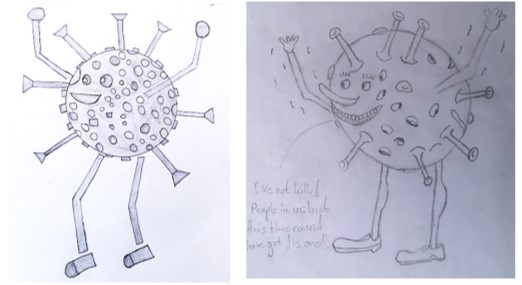 | Images drawn as sketches for sculptures in pencil as caricatures depicting how covid-19 is ravaging spreading across the world like a bush fire. The smiling face and victorious gesture is symbolic of the success covid-19 has attained in penetrating territorial boundaries of countries across the world. With no imminent vaccine to cure the new pandemic, the global health experts are calling on governments to ensure more stringent measures to curb its spread. |
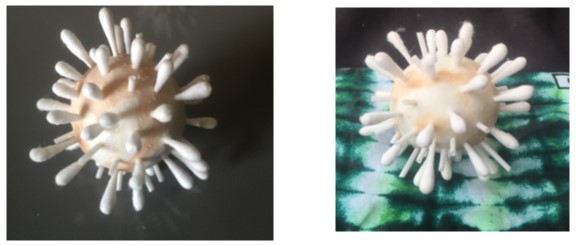 | A participant’s interpretation of the coronavirus in tangible material- soap and cotton swabs. This sculpture is close mimic of the scientific depiction of covid-19. Below are scenes captured during the designing and concept development processes. |
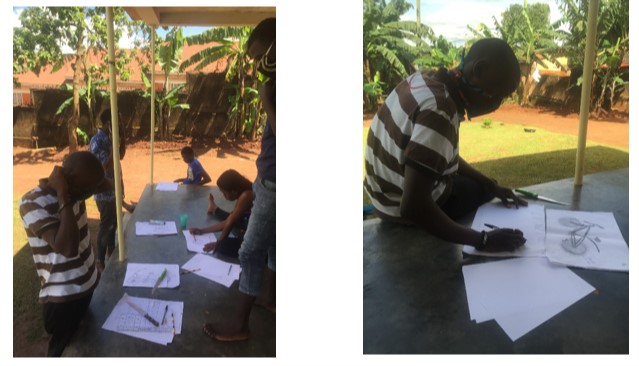 | Participants exploring the power of Individual responsibility in the face of covid-19; Social distancing and face-masking while developing design concepts during the workshop. |
BIBLIOGRAPHY
Ahabwe, C. (2020). Police warn bicycle riders for disobeying Museveni directives – PML Daily. PML Daily /Publications. Retrieved from https://www.pmldaily.com/news/2020/03/police-warn-bicycle-riders-for-disobeying-museveni-directives.html?fb_comment_id=3839603906082059_3839865769389206
Firth, R. (1972). The Interpretation of Ritual – Google Books. Retrieved March 30, 2020, from Book website: https://books.google.co.uk/books?hl=en&lr=&id=a4qRw8Wp1pEC&oi=fnd&pg=PA1&dq=the+culture+and+forms+of+greetings&ots=qqcPiqX6jI&sig=ocdYe485Qj9taRdO8sL8Dp3gywQ#v=onepage&q=the culture and forms of greetings&f=false
International AIDS Society. (2020). COVID-19 and HIV. In IAS report. Retrieved from https://www.iasociety.org/covid-19-hiv
Nalubwama, B. (2019). Music That Changed The Hiv/Aids Landscape In Uganda. New Vision Newspaper. Retrieved from https://www.newvision.co.ug/new_vision/news/1512125/music-changed-hiv-aids-landscape-uganda
Owiny, T. J. (2020). Uganda registers 15 new COVID-19 cases – Daily Monitor. Daily Monitor. Retrieved from https://www.monitor.co.ug/News/National/Uganda-registers-15-new-COVID19-cases-Elegu-Mwebesa/688334-5560260-r29ywq/index.html
The Guardian. (2020). Coronavirus in Africa: what happens next? | Global development | The Guardian. Retrieved April 8, 2020, from The Guardian Newspaper website: https://www.theguardian.com/global-development/2020/apr/08/coronavirus-in-africa-what-happens-next
Tugume, J. (2020). Eight New Cases Of Covid 19 Confirmed In Uganda. New Vision Newspaper. Retrieved from https://www.newvision.co.ug/new_vision/news/1516967/breaking-news-covid-19-confirmed-uganda
World Health Organisation. (2020). Advice for public. Retrieved from https://www.who.int/emergencies/diseases/novel-coronavirus-2019/advice-for-public

